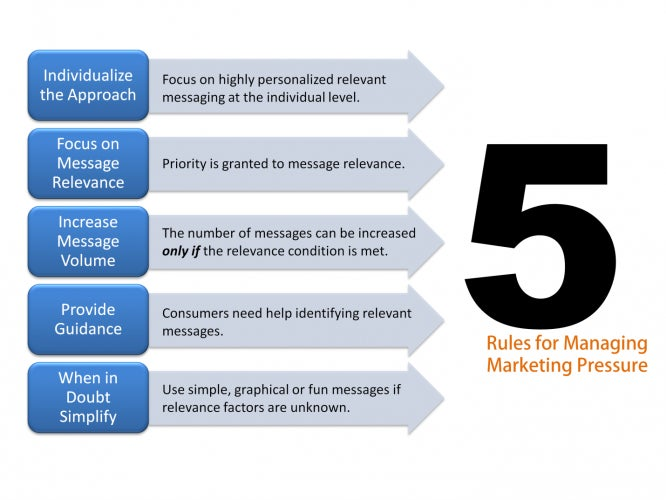5 Rules to Reduce Marketing Fatigue While Maximizing Revenue

If your email database is suffering from the dreaded marketing fatigue, you are not alone. Email marketers everywhere are struggling to find the right message frequency. However, there is good news! Based on a first-of-its-kind empirical study I discussed in an earlier post, we have proof that you can achieve a reasonable open rate, even if you increase the number of messages you send. Marketing fatigue does not appear tied to message frequency; instead, it appears tied to message relevancy.
So to reduce marketing fatigue, we must adhere to rules that have proven successful. I have followed five specific rules that have proven successful when communicating with an email audience.
Individualize the approach
First, to minimize marketing pressure, it’s critical to manage relevance and fatigue on a consumer-by-consumer basis. Deploy a one-to-one contact management strategy where communications are optimized using purchase data, behavior, demographics, preferences, etc. (Don’t forget to fold in offline data!) And rather than using the traditional approach, where marketers apply a generic threshold to all customers and prospects, communication thresholds should be defined by message relevance to each recipient, on an individual basis, to maximize sales.
Focus on message relevance
If a consumer determines an email subject is not relevant, there is little impact, negative or positive, on a brand or consumer perception. However, if a message is opened that the consumer thinks is relevant, and it turns out to be irrelevant, this damages the brand and decreases future chances of success. So make sure you anticipate relevance and adapt your message based on expected relevancy.
Increase message volume
Once the content relevance has been met, marketers can increase, to a certain point, the volume and frequency of communication, but only if subsequent impressions are designed to continue delivering highly personalized and relevant messages. Research shows that marketers can send relevant messages multiple times to achieve results. This means that more relevance doesn’t necessarily require the level of message complexity to rise exponentially for marketing success.
Provide guidance
Don’t leave it up to consumers to guess whether or not messages are relevant. Rather, make it clear by using subject lines that will help them decide whether to open the message. Remember that there’s no penalty for helping consumers classify messages as irrelevant before they open them.
When in doubt, simplify
If we cannot determine if a message is relevant enough, then it’s best to use a simple, graphical, or fun approach. Keep viewers’ effort level low. In these circumstances, the less the viewer has to comb through, the less likely you will create a negative outcome.
Next Steps: Actions You Should Take Tomorrow
1. Drawing on the conclusions of the Micheaux study, I believe the solution to marketing fatigue could be to create a content-relevance scoring model. This approach could leverage a relevance indicator for each recipient/message couple. The indicator could be calculated using all the information available on recipients (channel behavior, demographics, profile information, preferences, propensity to buy, etc.). Communication strategies could then be uniquely assigned and tracked based on the value of the relevance indicator, much like a scoring engine uses thresholds and business rules to optimize targets for marketing campaigns based on buying behavior.
If the indicator shows the message will be very relevant, then the format can be whatever you wish. If it is relevant, you must minimize the effort required to read the message and take action. If the indicator shows uncertain relevance, you will need to captivate the recipient either by the format you select (images, animations) or content you deliver (important announcements, offers). If the indicator predicts little chance of being relevant: will you be brave enough to not send the message?
2. Create this indicator and revolutionize the way we do marketing by assessing the relevance of every single communication before personalizing each message on a one-to-one basis. Today, conversational marketing technologies help enable this type of intelligent and individualized information management. Thanks to cross-channel campaign management, inbound and outbound communication fusion, and real-time personalization and recommendation engines marketers have all the necessary capabilities to create and capitalize on customer knowledge, and to ultimately calculate a relevance indicator to automatically adapt message form, content, and frequency.
If we put the right strategy in place, one that is focused on message relevancy, we can fight marketing fatigue—and we can improve the relationship we enter into with our audience. Look at your existing email strategy. Are there ways you could fold in these five rules? Are there other rules you have found successful when you are faced with marketing fatigue?
